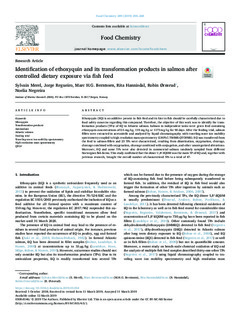Identification of ethoxyquin and its transformation products in salmon after controlled dietary exposure via fish feed
Merel, Sylvain Alain Yves; Regueiro, Jorge; Berntssen, Marc; Hannisdal, Rita; Ørnsrud, Robin; Negreira, Noelia
Journal article, Peer reviewed
Published version
Date
2019Metadata
Show full item recordCollections
- Articles [3012]
- Publikasjoner fra CRIStin [3066]
Abstract
Ethoxyquin (EQ) is an additive present in fish feed and its fate in fish should be carefully characterized due to food safety concerns regarding this compound. Therefore, the objective of this work was to identify the transformation products (TPs) of EQ in Atlantic salmon. Salmon in independent tanks were given feed containing ethoxyquin concentrations of 0.5 mg/kg, 119 mg/kg or 1173 mg/kg for 90 days. After the feeding trial, salmon fillets were extracted in acetonitrile and analyzed by liquid chromatography with traveling-wave ion mobility spectrometry coupled to high resolution mass spectrometry (UHPLC-TWIMS-QTOFMS). EQ was transferred from the feed to salmon fillets and 23 TPs were characterized, resulting from dimerization, oxygenation, cleavage, cleavage combined with oxygenation, cleavage combined with conjugation, and other uncategorized alterations. Moreover, EQ and some TPs were also detected in commercial salmon randomly sampled from different Norwegian fish farms. This study confirmed that the dimer 1,8′-EQDM was the main TP of EQ and, together with previous research, brought the overall number of characterized TPs to a total of 47.
